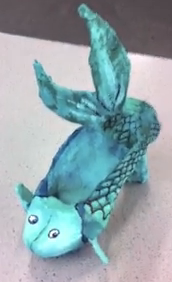
Here is a cut-down version of the rock guitars project I featured on here before. This is a 3D making activity that takes about 4 weeks (one hour per week) with Year 8 students but in theory could be done with Year 6 post-SATs as part of an arts activity week.
What you will need:
- Old shoes
- Cling film / saran wrap
- Modrock / plaster impregnated bandages (large box)
- Thin card from old boxes or greyboard
- Scissors
- Powder paints or acrylic paint if you can afford it!
Inspiration

African Sonata by Vladimir Kush is a great example of the application of surrealist elements to familiar shapes; the trunk reminds the artist of the tuba so becomes one! Much of Dali’s inspiration comes from a similar visual-reminiscence technique such as Lobster Telephone etc. So, after a discussion on personal interests, symbols and objects that reflect student’s personalities we looked at a selection of Dali landscapes (including Persistence of Memory featuring floppy clocks and dancing ants). Next step is unusual shoe designs…
We looked at a few odd designs collected into a Pinterest board that included Lady Gaga’s weird shoes by Alexander McQueen and the Yamamoto Adidas F50 Tigers (above image) that raised a great deal of debate due to the multitude of day-glo boots in FiFA World Cup Brazil 2014. We discussed things like football predators/attack and defence, snakeskin vipers and got quite a lot of descriptive writing to accompany sketches of own shoes and trainers.
METHOD
It is essential that you use old shoes – most people have a few shoes too small to fit or unusable old sports kit otherwise a charity shop or car boot sale is a great place to find some. Remove laces if there are any left! Shoes can be let inside the plaster bandage but this adds to the weight and they can only be used once. Equally, you could use serviceable shoes and cling film to cast and reuse. Use the cling film to cover one end or side of the shoe, you don’t need to mummify the whole thing but enough to be able to remove the modrock after setting. Cut the modrock bandage into 10cm strips, add warm water and overlap on shoe/cling-filmed surface. There needs only to be about two layers thick and this will set hard within a half hour. Remove from the shoe and repeat for the back of the guitar body. The two casts can be modrocked together to form a solid structure.
The design for the surreal symbol(s) should be sketched on to cardboard and carefully cut with scissors or a craft knife. My Year 8s worked in pairs with different roles swapped between them. Next, attach the cardboard shape to the cast shoe body and use modrock strips to cover over the cardboard surface. Some shapes may need a bit of masking tape to keep in place until the plaster sets and large, heavy casted shapes need encouragement from some PVA glue. Once all the plaster modrock is set, you can keep coming back and adding more just by dampening the dry plaster and adding more shapes. I used powder paint as a cheap way of adding dense colour (acrylic might work out expensive and poster paint will be too transparent).
The Koi Carp shoe above was made as a demo piece; video below.
Feel free to use my demo video and if you should make one of your own to demonstrate an art skill or technique, simply tag it #teachlearnart and publicise through Twitter and I will add it to a growing art teacher resource site curated at teachlearnart.wordpress.com.
You must be logged in to post a comment.